| Designs | 683 | ||
| Arrangement of Designs | 688 |
||
| Rhythmic Repetition of Designs | 689 |
||
| Description of Coats | 699 |
||
683
JOCHELSON, THE KORYAK.
Designs.
—
In order to be able to distinguish the latest designs in orna-mentation from the ancient ones, we must first of all turn to that of funeral
dress
or of other articles connected with ritual, such as the dress used in
dancing at whale festivals, or to the ornamentation of articles no longer in
use,
such as quivers. The ornamentation of funeral clothes is especially
marked
by conservatism.
On
most of the funeral garments, ornamentation is made entirely of slit-embroidery,
overlaid seams, caught-in strips, and skin mosaic. Sinew and hair
applique occurs also, but not so frequently.
The
designs made in slit-embroidery have been described before, and
it
has been
stated that
caught-in strips
and wound
strips result in similar
684
JOCHELSON, THE KORYAK.
designs; characterized, however, by wider white lines as compared to the remaining black background. The more complicated forms do not appear in this technique; but we have, on the whole, series of rhythmically arranged rectangles, as shown, for instance, in the narrow strips containing white bars in Fig. 208.
There is another figure frequently found in the ornamentation of funeral and sometimes of ordinary clothing, — inscribed arches with elongated sides, or ovals with one end cut off. These figures may be seen on the two

|
funeral quivers before men-tioned.1 Embroidered figures of this kind are found on ancient Chukchee quivers2 and on some articles of the Alaskan Eskimo.3 It is very interesting that, in the ornamentation of funer- al and dancing costumes, we do not find any realistic repro- ductions of men and animals which could be considered as "guardians" of the dead or of the shamans, or of other |
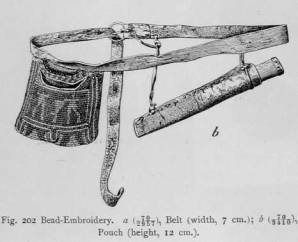
|
|
| Fig. 202. Bead-Embroidery. a, Belt (width, 7 cm.); b, Pouch (height, 12 cm.). |
persons who perform the religious dances. In the shamanistic costumes of the Yakut, the Tungus, and other Siberian tribes, we do find figures of "guardians" of shamans in the form of outlines of men and other animals. These figures are embroidered on the dress with sinew-thread; and sometimes figures cut out of leather, cloth, tin, or copper, or wrought from iron, are sewed on the dress.
Professor Boas has called attention to the difference in the decorative style applied in ceremonial and common objects among the Indians, the Eskimo, and the Gold of the Amur River.4 Their ceremonial objects are
1
See Part I, Fig. 50, p. 107;
also Fig. 43, p. 106; and Fig. 227 of this part.
2
See
Bogoras, Chukchee Material Life, Plate XI, Fig. 1; The Chukchee, Vol. VII of
this series, Fig. 76, p.157.
3
See
Nelson, Plate xlv, Figs. 15, 31,
32; Plate XX, Fig. 6.
4
See
Boas, The
Decorative Art
of the North
American Indians (Popular
Science Monthly, October, 1903,
pp. 484, 485).
685
JOCHELSON, THE KORYAK.
covered with more or less realistic designs, while the decoration of ordinary garments represents geometrical motives. I have stated that the same phenomenon occurs among the Yakut and Tungus in reference to the decor- ation of their shaman's and ordinary wearing-apparel. We see the reverse among the Koryak. Their funeral and dancing garments are covered with geometrical designs, and realistic designs are found only among the decorative motives of ordinary coats and on fur rugs.
In the ornamentation of funeral garments there is only one case of a figure resembling a starfish,1 and another resembling a frog. An ancient Chukchee quiver has embroidered figures resembling the Russian letter ,- which could be mistaken for a conventionalized frog. I point this out, be- cause, in the Gilyak cult, the frog plays an important part, and its figure serves as an amulet.3 In Yukaghir mythology the frog is mentioned,4 but neither in the Koryak nor in the Chukchee myths do we meet with the frog.5
This may be the proper place to say a few words as to the part played by figures in the decorative art of the Koryak in general. If we are to assume that, in the case of all tribes, every ornament has, or had at one time, a certain meaning, then I must confess that I have not succeeded in finding the required explanations, either because the Koryak have forgotten the meaning of their ancient ornaments, or because the particular persons from whom I tried to obtain the explanations were not familiar with them, in which case the subject still remains to be investigated.
I was able to ascertain that all ornamental designs on dresses, as well as the tattooings, are called by the same name — ka'li or ke'le — as is used by the Koryak to designate, not only all kinds of drawings, but also the printing in books and Russian letters. Some Koryak said that simple, double, and concentric circles represent the sun, the moon, or the stars. I was told on one occasion that zigzags represent mountains; on another, that they represent waves. Cross-like figures are supposed to represent flying birds; but I was told that as a general rule the ornament had no special significance. Even the information as to zigzags I obtained only after insistentquestioning, which may have stimulated the answer. The impression obtained by me was, that the persons interrogated were considering their replies while being questioned. For that reason, I do not attach special importance to their answers. It will be clearly apparent from what follows, that the women
1
See woman's funeral overcoat,
Part I, Fig. 51, p. 108.
2
See
Bogoras, Chukchee Material Life, Plate XI, Fig. 2.
3 See Schrenck, III, p. 750.
4
See
Jochelson, Yukaghir Materials, p. 5.
5
Mr.
Sternberg has called my attention to the resemblance of some figures in the
Koryak-Chukchee decorative
art to Gilyak representations of
the frog; but I have
never seen
a frog in the
country of the Koryak. Neither
Krasheninnikoff (I, p. 492)
nor Dittmar
(Reisen in Kamtschatka, p. 345) found it in Kamchatka.
If the ornament
in question
really represents
a frog, this pattern must
have been adopted from the south.
I should add, however,
that, according to Slunin's assertions (see Slunin, I, p. 339), one
species of frog has been found in Kamchatka.
686
JOCHELSON, THE KORYAK.
use the designs employed in the ornamentation of the common dress, which have undoubtedly been adopted from the Russians or the Tungus, merely for beauty, without reference to their meaning.
Although, in the ornamentation of the common dress, we meet with ancient designs which we have seen on funeral clothes, yet we frequently find, also, realistic representations of men and animals, combinations of curved lines and conventionalized plants. The realistic reproductions of animals in dress-ornamentation may have developed as a result of the imitation by women, in their designs, of the objects produced by men in their sculptural art. Combinations of curved lines and conventionalized animals, such as we have seen on knives and spears, were adopted, in my opinion, from the Amur through the medium of the Tungus; while the conventionalized plants, as we shall see further on, were copied from the designs on the calico prints im- ported by Russian merchants. Some woman referred to the Russo-Koryak half-breed Fletcher1 as the author of certain patterns. These were mostly figures representing conventionalized plants, copied from designs on imported calico or cloth. The woman using them knows that the design represents plants and leaves, but personally I know of no case where a woman would imitate plants which grow naturally before her eyes.
It is claimed that, among advanced agricultural tribes, the plant-ornament appears in decorative art after the animal-ornament. I should add, however, that, as regards the plant in Fig. 204, (3), or that on the rug in Fig. 239, I was told that it represents the flower of the dog-brier, which grows in abun- dance in the valleys of the Koryak rivers. One Koryak even told me thatsome women copied the figures for the leather patterns from leaves and flowers of living plants. I admit the possibility of this, although personally I have not met such women. As the habit of observation on the part of man when on his hunting expeditions furnishes him with material for carvings and engravings, so does the observation of woman when gathering berries, herbs, and roots, supply her with material for designs.
How women copy figures from drawings on imported calico prints and other tissues is shown in Fig. 203, representing specimens which I obtained from a girl in Kamenskoye. Fig. 203, a, represents a conventionalized plant- ornament as it appeared on a piece of Russian calico which I obtained from the woman; b, the pattern, is a copy reproduced by the woman from a. The pattern is cut out of a piece of the thick skin of a thong-seal. We can see that the copy is rather crude. It shows a freehand, rough silhouette. This design was used in cutting out the patterns from the dark fur of the fawn in the following manner: the pattern is put on the obverse side of the fur, and by means of a bone knife its outline is drawn on the skin (some
See p. 665.
687
JOCHELSON, THE KORYAK.
women even use Russian pencils for that purpose), and the figure is then cut out with the woman's knife, following the outline. Fig. 203, c, shows how the conventionalized plant is sewed into the strip of white fur of a young
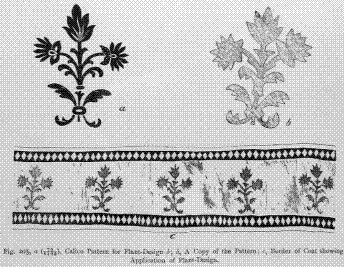
Fig. 203, a, Calico Pattern for Plant-Design b; b, ACopy of the Pattern; c, Border of Coat showing Application of Plant-Design.
reindeer, in place of the figures, which were cut out in the described manner by means of the pattern (b).
Fig. 204 represents a piece of a fur strip for trimming the bottom of an overcoat. The ornamental figures are a mixture of ancient animal and
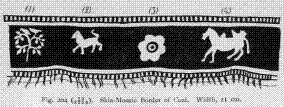
Fig. 204. Skin- Mosaic Boarder of Coat. Width, 21 cm.
plant ornaments. One figure represents a dog running, with its tail turned upward and its tongue hanging out. The other figure represents the sil- houette of a horse with a saddle, and a pack behind the saddle. In this
87—JESUP NORTH PACIFIC EXPED., VOL. VI, PART 2.
688
JOCHELSON, THE KORYAK.
silhouette it is very easy to recognize the horse. The use of the figure of a strange animal as a subject of decoration testifies to the power of observ- ation of the Koryak woman. Among the plant-figures, one represents a flower, the other- a bush with two birds sitting on it.
Later on, strips for trimming the bottoms of coats will be fully discussed. The middle part of many of these strips is embroidered with colored thread, in imitation of Russian designs. The cross in Fig. 211, in cotton thread, seems to have been adopted from Russian designs; while in Fig. 212 the entire strip, embroidered in silk, represents conventionalized plants.
Where fur mosaic occurs in funeral garments, we find only square, diago-nal, rhomb, or triangular checker-work, or narrow parallel strips in various arrangements, but no realistic figures. Thus it will be seen that all the characteristic ornamentation of funeral dresses consists of geometric designs.
Arrangement of Designs. — In treating of the arrangement of designs, three important points of view must be borne in mind, — the sequence of strips making up ornamental borders, the rhythmic repetition of motives recurring these strips, and their arrangement on the garments.
As regards the composition of borders from single strips, it would seem that the fundamental trait of arrangement consists in the attempt to set off a well-marked middle decorated stripe, which is accompanied by wider or narrower borders. Examples of such borders are fully discussed in the fol- lowing pages. The arrangement differs somewhat, according to the technique applied. Whenever the upper and lower borders of the ornamental strip are made of slit-embroidery, forms like those shown in Figs. 206-208 and 220- 223 are found. Borders made of applique-work are very common, and these consist almost always of white triangles on a black or red background, asshown in Figs. 208, 212, and 216. Square checker-work in this arrangement is shown in Figs. 205, 220, and 223. Triangular or square checker-work is also made in skin mosaic, as illustrated in Fig. 209. The arrangement of the strips shows so much variation, however, that it is difficult to give any generalized description. The same kind ofarrangement has also been applied in modern borders, with the only difference that for the ornamental middle row a strip of yarn or silk embroidery has been substituted.
The arrangement of stripes illustrated in Figs. 212 and 216, a, is found in many coats with embroidery; is also laid out on the same plan, except that under the lower row of white appliquéed hanging- triangles a row of checker-work is repeated. Sometimes, in place of the rhomboid checker-work, square checker-work is found. In one specimen the upper checkered strip is missing. In still another specimen only the central embroidery with the adjoining applique strips of triangles are retained. In another one we find, in place of the upper strip of checker-work, a single row of alternate black and white squares, while in all
689
JOCHELSON, THE KORYAK.
other respects the arrangement of the border is the same as in the specimens just described. In a few coats (for instance) the strips with applique triangles are replaced by slit-embroidery. The same is done in specimen, where, however, in the upper border, the slit-embroidery representing standing triangles is inserted between a strip of blue cloth with applique standing triangles and yarn embroidery. Under the embroidery, in the place usually occupied by the hanging applique triangles, we find black skin with rectangles in slit-embroidery. Two of these coats in which the slit-embroidery is used are dancing-coats made of skin dyed red.
Rhythmic Repetition of Designs. — More interesting than the succession of strips making up the border is the rhythmic repetition of motives in each strip and in the combined pattern constituting the whole width of the border. On the whole, there is a strong tendency to use alternate patterns intended to break the uniformity of an uninterrupted long border; but in many cases the rhythmic arrangement is much more intricate. In other cases the whole front of the coat is occupied by one pattern, while a change of arrangementtakes place on the back. In still other cases the right and left sides of the back show different patterns. In the majority of cases there is one place in which the symmetrical or rhythmic arrangement of the patterns is interrupted.

Fig. 205. Funeral Belt. Width, 4.5 cm.
This place is generally found under the left arm, not quite so often under he right arm. In some cases an exceptional pattern which does not fit into the whole rhythmic series is inserted at this place. This may be due to the difficulty of adjusting the strip to the garment; but from this difficulty a tendency seems to have developed to make a break in the design, even when not necessary.
It seems best to illustrate the peculiar tendency to rhythmic arrangement by the discussion of a number of borders. Fig. 205 represents part of a belt used in a man's funeral dress. The checker-work is made by weaving white dog-skin through slits in black hide. The ends of the slits are connected with applique hair embroidery. Each pair of white applique circles on the central strip is succeeded by one red circle.
Fig. 206 also represents part of a belt of a funeral dress. It consists of a strip of black skin on which right-angled figures are made in slit-embroi- dery. The numbers of links in the central connecting chain vary somewhat from three to six, the distances between the bars and squares not being quite
690
JOCHELSON, THE KORYAK.
regular. On the whole, the squares and their distances apart are a little wider in the middle of the strip than at the ends. Towards the ends the squares are a little narrower, and they are slightly closer together. The end auares number about eight stitches across. The middle squares number ten or eleven. Throughout, the same width of the design, thirteen stitches, —

Fig. 206. Funeral Belt with Slit-Embroidery. Width, 4.5 cm.
that is, six stitches either side of the middle line, — is preserved. The second square from the left, here illustrated, shows an irregularity in the bottom row, in that two adjoining slits are treated as a unit.
Fig. 207 is part of a wide border of a funeral coat which is trimmed with dog-fur. The whole border consists of alternate strips of black and white skin sewed together. The lowest strip is made of shorn reindeer-skin with

Fig. 207. Border of Funeral Coat with Slit-Embroidery. Width, 8.5 cm.
the flesh side up, dyed red. The designs on the upper row are arranged quite symmetrically. As shown in the illustration, these are of varying lengths, which are arranged as follows: —
|
Center |
|||||||||||||||
| cm | 8 | 12 | 8 | 17 | 12.5 | 22 | 9 | 9 | 22 | 12 | 17 | 8 | 11 | 8 | cm |
| Under arm. | Under arm. | ||||||||||||||
At the intervals hair tassels are caught in the seam. The vertical bars on this design consist, in the middle part, of single rows of stitches; while at both ends of the strip there is a tendency to substitute double rows, although not quite regularly. Seen from a distance, the impression is given that the middle part, which was probably placed on the front of the coat, contains finer and more regular work than the back, where the vertical bars are farther apart and heavier. The whole middle portion of the central black strip of the design consists of a regular alternation of rectangular fields of six andthree stitches, as shown in the illustration, except that there is a slight irregularity in the occurrence here and there of three 3-stitch fields instead
691
JOCHELSON, THE KORYAK.
of two 3-stitch fields, as would be required by perfect regularity. This portion of the black middle strip extends from the point where the 17 cm. bar of the top row on the left adjoins the 12.5 cm. bar, to the middle of the 17 cm. on the right. The whole rest of the left side of this strip is occupied by one continuous row of 3-stitch squares with only slight variations, while the whole rest of the right-hand side continues with a design the same as the one in the lower black strip, only a little narrower. If this interpretation is correct, the front would be occupied by one design, and the left and right of the back each by a different design. The white strip under the central black strip just described is embroidered in red yarn, except that portion which is under the two narrow bars of the upper row in the middle of the whole strip, which is done in green. It is obvious from this arrangement that the point indicated in the illustration is the centre of the front of the design. The usual fringe of caught-in strips and hair tassels finishes the lower edge. Fig. 208 represents a strip for trimming the skirt of a woman's dancing-
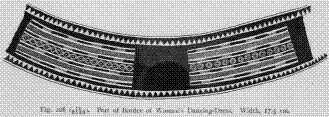
Fig.
208. Part of Border of Woman's Dancing-Dress. Width, 17.5 cm.
dress. The outer border of triangles is done in white skin appliquéed on dark-red skin. The central ornamental row is done in slit-embroidery. The series of two patterns shown in this illustration are repeated three times along the lower border of the coat. There are two types of circular designs on the

Fig.209. Part of Border of Funeral Dress made of Skin Mosaic.
middle row, — one with a cross in the middle, the other forming a double star. On the whole, they alternate in groups of three.
Fig. 209 represents another strip for trimming the skirt of the funeral
692
JOCHELSON, THE KORYAK.
dress This one is made of small strips and pieces of black and white fur`of young reindeer, sewed together, with the fur outside. The ornamentation is exclusively linear and geometric. The double zigzag on the middle strip, interrupted by cross-strips of white and black fur, is frequently found, both in ancient and modern Koryak ornamentation.1 The fields containing the zig- zag are separated by rectangular fields consisting of a broad middle stripe ot red, bordered on each side by a narrow strip of black and white skin. Most of the red strips are made of reindeer-skin inserted with the inner side outward. To these are sewed four rows of tufts of young seal-skin hair dyed red. The seven red strips on the left are made of dyed skin without hair-tufts. The white strips with zigzag are not of equal length, but there is no clear evidence of intentional order in their arrangement. In one part of the design a wide and a narrow one seem to alternate quite regularly, while in other parts there seem to be groups of narrow ones followed by groups of wide ones. The triangular borders above and below seem to be arranged so that each stripe is quite independent of the others. There is no attempt to make the triangles either alternate or coincide so as to form rhombi.
The motive of a very beautiful border of a skin coat is illustrated in Fig. 210. It consists of a series of strips of skin embroidery, wrapped skin, and caught-in strips; the two broad white strips being made of wrapped skin, while the central and lowest strips are made of caught-in strips. The rhythmic arrangement of the motives in this specimen is very elaborate. The long fringe which is caught in a seam near the upper border is repeated at regular intervals. The slit-embroidery is interrupted at these places; and in place of the white bar design in the central strip, a piece of white skin is inserted under each fringe. The division of the upper row of slit-embroidery into three parts of unequal length will be noticed. Just under the intervals there are two tufts of seal-fur, a little wider below than on top, and these are setoff more definitely by the arrangement of the caught-in strips in the lowest two rows. The beaded effect in the lower seams is brought about by very short caught-in strips of reindeer-skin.
It may be well to discuss at this place the rhythmic arrangement of more modern patterns, because apparently the principles of their rhythmic arrange- ment are the same as those used in older patterns. In the border shown in Fig. 204 the figures are arranged in one wider and one narrower symmetrical group. The wider group was probably intended to form the front of the coat. In this case, the front would contain the figures in the order —
flower, horse, dog, bush, dog, horse, flower;
while the grouping on the back between the two terminal flowers would have been dog, bush, dog.
1 See Part I, Figs. 43, 44. p. 106; Fig. 48, p. 107; and Fig. 53, p. 109.
693
JOCHELSON, THE KORYAK.
Some of the rectangles with rhombic checkers in an embroidered stripe (Fig. 211) have a white background. In these there are two rows of blue (or purple) rhombi at each end, and two middle rows of red rhombi (design 1).
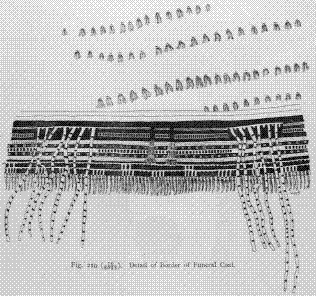
Fig. 210. Detail of Border of Funeral Coat.
Other rectangles have a yellow background, with red rhombi at the sides and blue ones in the middle (2). Besides, there is one rectangle with red back-ground and black rhombi (3). The colors of the crosses are irregularly

Fig. 211. Part of Coat- Border made of Embroidery in Skin Mosaic. Width, 16 cm.
arranged. There are four with predominating red and white (4), and five with predominating yellow and blue (5). The most symmetrical arrangement of this type would result in a yellow rectangle in the middle of the front.
694
JOCHELSON, THE KORYAK.
One end of the strip (shown in the illustration) shows three short blue bars on a red background (6). The peculiar cut at this end fits into a conrre- sponding cut at the other end, and shows that the strip has been taken off as it is from a garment. The general impression of the design is that the symmetry of the crosses is subordinate to the symmetry of the rectangles. For this reason I have placed the crosses in the arrangement of the symmetry in the upper line.
| 4 | 5 | 5 | 5 | 4 | 5 | 4 | 4 | 5 | 4 | 6 |
| 2 | I | I | 2 | I | I | 2 | I | 3 | I | |
|
Front |
Back | |||||||||
The embroidery in Fig. 212 consists of four distinct elements, — one flower with leaves on each side (1), one branch with curved leaves (2), and one branch with terminal flowers (3); besides these, there is one other element
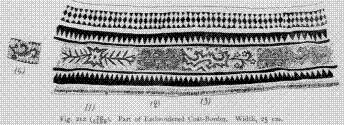
Fig.
212. Part of Embroidered Coat-Border. Width, 25 cm.
which occurs only once on the back of the coat, which is marked (4). The embroidered strip is not sewed symmetrically to the coat, but it has evidently been planned in such a way that the arrangement in front of the coat corre- sponds to the following sequence: —
2 3 2 1 3 1 2 3 2;
while the back is occupied by three designs of the pattern (3). On the back the small design (4) is found, the small designs on the whole back being arranged in the order —
2 2 4 2.
On another coat not illustrated here a similar kind of embroidery is found. The pattern consists all round of alternating rectangles containing a sinuous stem with triangular leaves and terminal flower (corresponding to design 3 of Fig. 212). This alternates with a symmetrical double design consisting of central flower and two pairs of diverging branches, which join again near the end, enclosing a heart-shaped space, and then diverge again, bearing at their recurving ends a single terminal flower. The only irregu-
695
JOCHELSON, THE KORYAK.
larity in this design is again under the left arm, where one half of a sym-metrical design is inserted between the two designs that would regularly succeed each other at this place.
The embroidered design of the coat is the same as the one just described, the symmetrical design being in the middle of the front and of the back. Here an irregularity occurs under the right arm, where two of the asymmetrical designs are placed in succession. This asymmetry is emphasized by the division of the background of the design into a right darker and a left lighter half.
On a third yarn-embroidered coat an irregularity is found under the left arm, where, in place of the symmetrical design, is inserted a rectangle which is divided into five equal strips running in the direction of the border.
|
The upper, middle, and lower stripes are red; while the intervening ones consist of nine squares of colored yarn, the middle one being green, and these being followed on both sides by a series of white, blue, yellow, blue squares. |
|
|
Fig 213 Embroidery from Lower Border of Coat. |
The embroidery of another coat (Fig. 213) consists of rectangles with a double-leaf design, which alternates with a red background and a background in greenish and bluish tints. The red varies from a light pink to a deep red, while the others vary from a very dark blue, almost black, to a bright green.
In one coat (Fig. 214) we have all round a double-leaf design on a

Fig. 214. Designs from the Lower Border of an Embroidered Coat.
single background alternating with another design consisting of three crosses. This pair of designs occurs in regular succession five times, but under the left arm it is interrupted by the two new patterns shown on the right-hand side of the figure.
In still another coat (Fig. 215) we find the same series of designs in symmetrical arrangement on the front and on the back. The middle is occupied by a cross, and the other designs follow as indicated. Under the right arm an additional design, consisting of the central cross and the rhom- boidal fields with central dots, appears; while under the left arm a single field is added, differing in color from all the others, but related to them in form.
Fig. 216, a, represents an ornamented coat of reindeer-fur. The middle trip of the coat-border consists of conventionalized plants embroidered in colored
88—JESUP NORTH PACIFIC EXPED., VOL. VI. PART 2.
696
JOCHELSON, THE KORYAK.
silks. The designs in front are symmetrically arranged. The centre is occu-pied by a double leaf, evidently the same as the leaf with flower which is found to the left and to the right in the second position. Adjoining the central leaf is a simple flower, which on the front of the coat occurs again

Fig.
215. Designs from the Lower Border of an Embroidered Coat.
following the flower with double leaf. Under the left arm of the coat the symmetry is broken by the insertion of a single flower in place of the flower with double leaf, which occupies the corresponding place under the
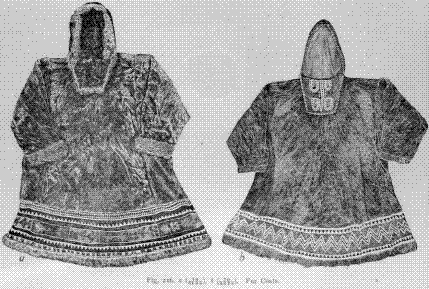
Fig.
216. Fur Coats
right arm. On the back we find four single flowers, all turned in the same direction. The color-scheme seems very irregular. In front the central field is blue with a red leaf. The two adjoining fields are bright yellow,
697
JOCHELSON, THE KORYAK.
with, on the one side a red, on the other side a purple, flower. The fol-Winc fields of central flower with double leaf are, on the right-hand side of the coat a central blue and lateral purple background, on which the flower is embroidered in red with yellow outline, the leaves with light greenish-blue, and red veins. On the left-hand side the central background is black, the lateral background blue, on which the flower is embroidered in fawn-color, the leaves in bright red with greenish-blue veins; i.e., the reverse arrange- ment of those on the right side. On the whole, it would seem that in the
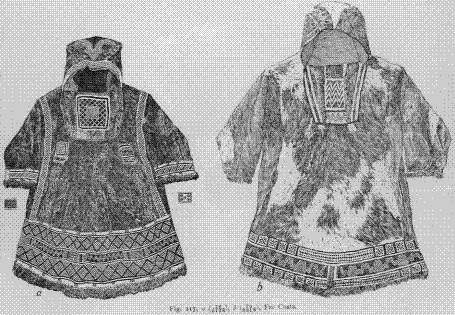
Fig. 217. a,b Fur Coats.
color-scheme, yellow and pink and intermediate tints are almost equivalent, while blue and purple and intermediate tints are also equivalent.
In the fur coat a break in the continuity of the design along the lower border occurs under the left arm. The narrow white strip of skin which forms the upper edge of the border alone is continued. All the other designs are replaced by a single piece of reindeer-skin, which is set in. Besides this, one element of the embroidered design is replaced by a piece of reindeer-skin.
698
JOCHELSON, THE KORYAK.
In the coat illustrated in Fig. 216, b, there is a narrow inset in the border on the left-hand side, in which the zigzag pattern is continued; the zigzags, however, being much closer together than in the rest of the pattern.
In the beautiful coat illustrated in Fig. 217, a, there is also a break in the lower border on the left side of the coat. Instead of the upper and lower strips of checker-work, we find stripes of plain dark fawn-skin. In the upper one there is a central square field surrounded by a narrow white stripe, and containing seven rows of dark and light checkers. The lower row has three
|
|
such squares with`somewhat
coarser`borders
and check-ers.
In the middlerow
the zigzag or-nament,
which atthis
place should be interrupted by a
rec- tangular inset, is
continued as a zig-
zag line. This inter- ruption of the regu-
larity of the border
may be seen in the
illustration.
Fig. 2 17, b, shows a man's coat made in Kamenskoye. The middle strip of the ornamental trim- ming of the skirt is embroidered |
|
Fig.218. Skin Coat wuth Stamped Designs. |
with beads of three colors, — blue, black, and white. The zigzag in the middle resembles the repetition of the letter M, and consists of two side curves of white eads and a middle curve of red beads. The portion of the blue background under some of the crests of the wave-line is made in light-blue color, which alternates with dark blue, but not quite regularly. The left side of one crest rises over a line of blue; and the adjoining crest, including the two lesser crests on each side, rises over a black background. On the left side, from the middle of the front to the middle of the back, this arrangement alter- nates regularly; while on the right side of the coat the light blue under one wave-crest alternates with dark blue under two wave-crests. In the middle of the five wave-crests on the back, which rise over light blue, a number of red beads are placed in the middle under the crest of the wave. The blue
699
JOCHELSON, THE KORYAK.
all round the coat, over the waves, is made of blue beads of medium deep color. The arrangement of the lower border is asymmetrical.
Fig. 218 represents a shirt of soft dressed white reindeer-skin, which bears the imprint of stamps in the shape of rings, stars, etc., all of a red color obtained from the extract of alder-bark. The rings and stars are foundin ancient Koryak ornaments. The other figures, I believe, were adopted from Russian designs. The shirt is ornamented with six different figures; the stamps for three of them, cut out of wood, being shown in Fig. 201. This method of colored decoration is used by the Indians of the Ungava district in ornamenting their buckskin dress. They also use paint-sticks on these occasions.1 The arrangement of these designs is symmetrical. If we call the designs from the middle line on towards the sides 1, 2, 3, 4, the arrangement is, for each quarter, 1 2 3 4 1 2 3; the last one (3), which has the circle with the inscribed cross,2 being at each side under the arms, and belonging to both the design at the back and to the design in front.
Often the flap which hangs down over the chest, and which may be used for protecting the face, is decorated, as shown in Figs. 216, b, and 217. On another coat the flap is decorated with a white upright cross, under which there are two white circles. Another type of decoration of the flap, which occurs on two coats, is shown in Fig. 219. The flap of a woman's dancing-coat is decorated with rhomboidal checker-work made of dark and white fur. The fourth and sixth dark lines of these rhombi from each side are made of skin dyed red, which, even when looked at from a little distance, is hardly distinguishable from the brown reindeer-fur. This whole square has thirteen vertical rows of white checkers. The top of the hood is sometimes decorated with a design which may represent reindeer-antlers, as shown in Fig. 217, a. This coat, one of the most beautiful specimens
1
See Turner, pp. 296, 297.
2
In
the account illustrated in Fig. 249 this design designates the number 100.
700
JOCHELSON, THE KORYAK.
of skin ornamentation, is elaborately decorated, somewhat in the style of dancing-coats. It is characterized by the decoration of the sleeves, — the vertical strips running up from the lower border to the shoulders, and down in the same way along the back, — and by the decorative patches on the chest. In other cases we find on the ceremonial coats a decorative middle strip, as in Part I, Plate I, Fig. 2; still others contain both the lateral strips just described and the middle strip, as shown in Fig. 51, p. 108. In the men's funeral coats these arrangements are even more complicated, and it seems best to describe a number of these coats in detail. Another characteristic trait of these highly decorated coats, particularly of dancing-coats made of skin dyed red, are tassels, which are often attached to skin rosettes (see Fig. 227).
Figs. 216 b and 217 a represent two men's coats made of skins of young reindeer, in the ornamentation of which we find only the figures with which we have become familiar in the ornamentation of funeral dress. The designs are made of bits of black and of white reindeer-fur, of tanned leather, and of dressed skins of two colors. The two strips of checker-ornament inFig. 217, a, are made up of squares of skin of three colors, — white, black, and brown. The entire ornament in this coat is made with wonderful skill,regularity, and regard for rhythm and symmetry.
The middle strip of the lower border contains a number of vertical stripes adjoining the triangular and checkered designs in this field. These small stripes are made up of seven or eight rows of bright-red tufts of wool, which appear as a continuous red field, contrasting forcibly, by its brightness, with the subdued colors of the skin. Down along; the back are two lateral stripes continuing the checkered lateral stripes of the front, which are the same in design as the small square on the left side of the chest, — two zigzags running down the back, bordered by a single white stripe. Front and back stripes meet exactly on the shoulder. The fields bordered by red, described before, in the middle line of the lower border, are all different. Those on the back are shown in Fig. 217, a, under the sleeves. On the back of the hood, just under the two horns of the figure shown in the front view, are two round white spots. The borders on the sleeves are similar in style to the lower border of the coat, the pattern consisting of checkers, — of one diagonal row made of the inner side of the skin, and followed by six diagonal stripes, alternating white and brown. The border of the hood is also similar in style. The small crosses are made of skin dyed red, while all the other squares are white and dark skin. The crosses in the horn-like design on the hood have centres of skin dyed red.
On a woman's dancing-coat (see Part I, Fig. 27, a, p. 68) we find elaborate decoration with tassels. The coat has two small beaded circles in front, and three groups of tassels, each consisting of a small patch of white
701
JOCHELSON, THE KORYAK.
skin with long pendants of the same material. There are also two pairs of black and white beaded strings on the front. On the back there are two circles near the shoulders, while farther down there are three pairs of tassels similar to those in front. They are attached to a small circle of white skin. The tassels attached to each of these are double; and the base of each tassel is wrapped with a piece of fur, which is again wrapped with a piece of blue cloth, around which a narrow strip of white skin is tied firmly in aspiral. These wrappings recall the wrappings of the braids of Eskimo women. On the back of the double-pointed hood there are also two small circles with concentric rings with tassels of white skin.
Patterns made only of skin mosaic are not common in coats of bare skin. One dancing-coat (Fig. 220), however, is decorated in this manner.
|
The checker-work of the middle strip of the lower border is made of skin mosaic, consisting in the main of white and black skin, from which is set oft at every ninth white square a large square made up of pieces of skin dyed red. Circles of skin mosaic are often placed at the base of tassels (see Fig. 227). |
|
|
Fig. 220. Part of Border of a Dancing-Coat. |
In Figs. 221 and 222 the details of ornamentation of the woman's funeral overcoat shown in back view in Part I, Fig. 51, p. 108, are given. The top of the hood is ornamented with a horseshoe-shaped border, the open side forward. The top of this border can be seen in the back view of the whole coat. The inside of this horseshoe is occupied by a rectangle standing on its narrow side, which consists of a piece of black skin surrounded by a narrow border of white skin without hair. On the black skin is checker-work made in slit- embroidery, each checker consisting of four rows of from five to eight slits. The rectangle is eight checkers wide by twelve high. The front of the coathas the same design as the back, except that the shoulder-strips terminate on both sides at the seams of the inset, which occupies the upper part of thechest, and which is covered by the chin-flap. That portion of the design rising over the horizontal waist-band shown in the back view is also absent. The border design of the hood, and the upper horizontal border on the front of the coat and the same border on the back, together with the whole border on the upper part of the back, are made up of the same elements (lower part of Fig. 221). In the design on the hood these appear in the order, from theinner side of the border to the outer side, chain of rectangles, circles, chain of rectangles, circles, white. In front they appear in the order white, circles, chain of rectangles, circles, white. It is worth remarking that in the middle of this strip, just over a central vertical strip, two double circles are
702
JOCHELSON, THE KORYAK.
applied, separated by one single circle. In the closed design on the upper part of the back the order is, from the inner side outward, white, circles, chain of rectangles, circles, chain of rectangles, circles, white, at the bottom and right and left; while on top the outer chain of rectangles is followed by a slit-design, shown in Fig. 221, in which the upper right-hand corner of the
|
|
closed design on the back, with the adjoining part of the shoulder-strip, is shown. The other strips — those on the shoulders, sleeves, and the vertical strips on the back are shown in the upper part of Fig. 221. They consist of applique work with overlaid seams. The large spots in the middle rows are made of skin dyed red. The lower border of the coat is similar to the borders previ- ously described, and is shown in Fig. 222. Under the right sleeve the regular pattern is interrupted. This part is shown in the illustration. The star in the triangle on the back is made of slit-em-broidery in white sinew and in colored yarn. Another coat has the usual lower border, and a vertical strip down the middle of the front in slit- embroidery (Fig. 223, a), and on each side on the |
|
Fig. 221. Detail of Ornamentation from a Woman's Funeral Coat, Borders on Right Shoulder. |
front of the chest, a rectangle consisting of seven stripes of checker-work on a black back- ground, surrounded by a border of white skin, and with three simple tassels of white slit skin at the bottom. The rectangle on the left side has an eighth row under the seven rows of checkers consisting
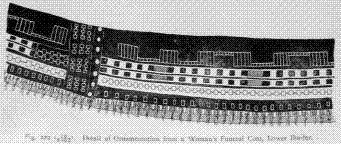
Fig.
222 Detail of Ornamentation from a Woman's Funeral Coat, Lower Border
of six circles. On the back of the coat, on each shoulder-blade, are rectan-gles of skin dyed red, with complicated irregular designs (Fig. 224) consisting of five checkered circles, a few small white circles, and checkered bars.
703
JOCHELSON, THE KORYAK.
A little lower down, and nearer the middle, are two large checkered rosettes; nd down the middle of the back runs a stripe the design of which is shown in Fig. 205. Around the sleeves, in the same position as shown in Part I, Fig. 51, p. 108, is a strip of black and white checker-work. The lower border consists of two narrow strips of slit-embroidery bordering a wide strip of checker-work done in applique (Fig. 223, b). Below this is a narrower strip,
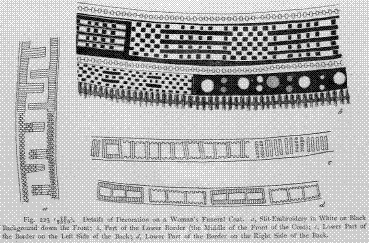
Fig. 223. Details of Decoration on a Woman's Funeral Coat. a, Slip- Embroidery in White on Black Background down the Front; b, Part of the Lower Border (the Middle of the Front of the Coat); c, Lower Part of the Border on the Left Side of the Back; d, Lower Part of the Border on the Right Side of the Back.
which consists partly of a similar kind of checker-work, partly of circular designs in appliqué-work, partly of slit-embroidery on a black background
| (Fig. 223, b-d). The upper wide strip consists of two different halves, occupying approximately the right and left border of the coat. Both parts of this strip are shown in Fig. 223, b. The lower border also consists of distinct designs. The design on the right-hand side of the front is seen on the left in Fig. 223, b; the one on the left side of the front is shown on the right in the same figure. The left side of the back is shown in c, while the right side of the back is shown in d. |
|
|
Fig. 224. Shoulder-Patch on Back of Woman's Funeral Coat |
Fig. 225 represents the front (a) and back (b) of a funeral coat; and Fig. 226 shows the front view of the upper part of the hood. The sleeves, skirt, and hood are trimmed all round with shaggy white
89—JESUP NORTH PACIFIC EXPED., VOL. VI, PART 2.
704
JOCHELSON, THE KORYAK.
dog-fur. The flap of shaggy fur sewed on at the neck is raised in the illustration.1 This is the way it rests on the corpse, so as to cover the face. The ornamentation is of the same character as in the case of the specimens
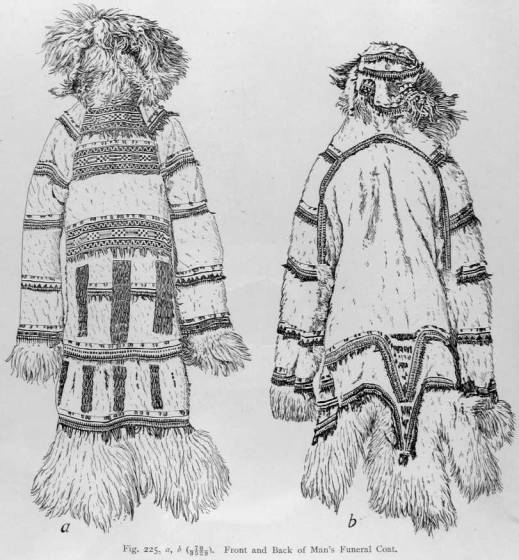
Fig.
225. a,b Front and Back of Man's Funerel Coat
in Figs. 205-208, only the embroidery in front is made mostly with colored silks instead of with the material formerly used for embroidery; namely, sinew-
1 In the illustration of the funeral
coat shown in Part I, Fig. 43, p. 106, this flap is concealed inside so as
not to cover up the ornamentation on
the chest. I call attention to this to prevent the erroneous conclusion that
there are funeral
coats without flaps, as is the case with ordinary coats.
705
JOCHELSON, THE KORYAK.
thread and hair of reindeer and other animals. The zigzags do not form sharp angles, but a wavy figure. It is of interest to note that some of the lines on the hood are embroidered with glass beads, which are not found in ancient ornaments, being an article with which the Koryak became familiar through the Russians or the Tungus. The women very conservatively avoid using beads in ornamenting articles having any relation to the cult. The dark, wide, vertical strips set into the white fur on the front part of the funeral coat are pieces of fur of a young seal dyed red. The tassels of hair
| under the embroidery are dyed the same color. The dark vertical stripes appear to be the inner side of the skin of reindeer. On the inside of the coat the rein- deer-hair cut short may be seen. The flesh side of the skin is dyed red, — in some cases light red, in most cases very dark. These vertical stripes are set with nine rows of tas-sels (the middle one with twelve), partly made of the hair of young seal, partly (on the middle stripes) made of crewel. Under the strips of embroidery, fringe con-sisting of red tassels and caught-in strips is sewedon. Along the strip of embroidery just over the |
|
|
Fig. 226. Hood of Man's Funeral Coat |
lowest row of vertical dark stripes, the fringe consists of alternate red and blue parts, which do not correspond to the lower vertical strips. The tassels under the lowest vertical strip are so arranged that there are five under the broader middle strip, while there are three under each of the four narrower strips which are found on each side of the front of the coat. In addition, there are three in the middle of each white space. Under the second stripe of embroidery running around the sleeve, under the shoulder, the tassels are red and light green. The embroidery between the single stripes on the front consists of black and white checkers, and rectangles consisting of three stripes, in which either the outer stripes are of a reddish to yellowish tinge, and the inner some bluish or violet color, or vice versa. There does not seem to be
706
JOCHELSON, THE KORYAK.
any regular arrangement of these colors. The narrow strip of embroidery running over neck and shoulders, between the sleeves and back, is also set with a red and green fringe. The fringe above the strip at the coat-tail consists of 2 red rows, I green, I red, I green, 2 red rows. At the side, between the two strips across the bottom of the coat, a broad vertical white strip is set in with embroideries. This may be seen on the left- hand side of the back view of the coat. In the seams running along the sides of the coat, from under the arms to the bottom border, there are tufts of red and blue yarn. The cap has two ears made of cylindrical pieces of fur, which may be seen in the back view of the whole garment. The design on the front (shown in Fig. 226) is made up, in the lower rows, of a mosaic of dark and light reindeer-fur, with red tassels between the two upper strips. Over this is the usual type of slit-embroidery surrounding a strip of em- broidery in thread. A similar arrangement is repeated on the upper part of the cap. The two rows of embroidery seen in the back view of the coat over the ears adjoin the row of tassels seen on the top of the cap in Fig. 226.
Fig. 227 represents the back of a woman's coat made of skins of young reindeer in Alutor, near Bering Sea. It is ornamented all over with bead- embroidery and loose bead-strings. The figures embroidered with beads on the skirt resemble the oval halves on the funeral quivers (see Part I, Fig. 50, p. 107). The two upper circles on the back are embroidered with beads, while the inner rings of the three lower circles consist of thin disks with imprints of the cross, and figures of animals sewed on. These disks, of course, are of foreign origin. The coat is made with the fur turned inside, and the skin on the outside is dyed brown.
A dancing-coat made of skin dyed red has tassels attached to circles. The lower border consists of a strip 12.5 cm. wide, edged above by appliquéed pendant triangles, below by standing triangles. Under the right arm the upper row is interrupted by three pendant bells, while under the left arm the lower row is interrupted by six standing bells.
The coat differs in style from the older coats. It is made of reindeer-skin, and has the cut of a European overcoat, the front being tied together with strings. Both sides of the front and the collar are trimmed with a strip of white fur. Each front is trimmed with a strip of alternate black and white checkered rectangles, the latter being bordered above and below by a strip of brown and a strip of white. The lower border consists of two rows of square checkers, beginning with a narrow strip of white, fol- lowed by a narrow strip of dark; then follows a 3-row checker-work of dark and white, which, in turn, is followed by one dark and one white strip. Under these is another strip of checker-work made up of squares slightly smaller than those of the upper row. While all the other upper strips are about 1 cm. wide, these checkers are only about 8 mm. wide. Instead of
707
JOCHELSON, THE KORYAK.
regular alternation of black and white diagonal squares, we have at intervals of approximately fourteen squares two heavier dark diagonal stripes made up of the regular diagonal series, — squares of dark fur, immediately followed by another series of squares made of skin dyed red. This is followed by a series of white squares; and next we find another diagonal of squares of skin dyed red followed by the regular series of squares of dark skin. These diagonals run from left below to right above. In one place there are two
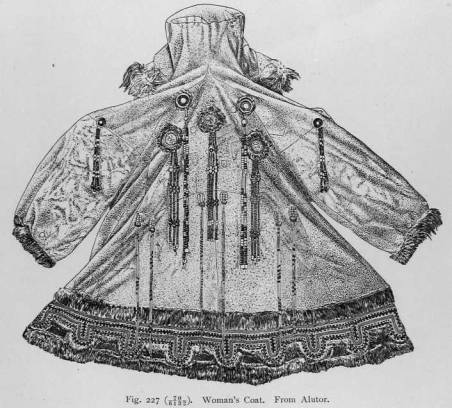
Fig. 227. Woman's Coat, From Alutor.
double dark diagonals separated by fields of checker-work. The sleeves are finished off with checker-work enclosed by one dark and one white strip.